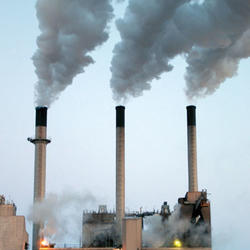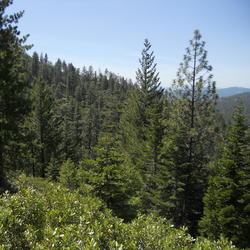A short video on how carbon can get into the atmosphere.
How does carbon get into the atmosphere?
Atmospheric carbon dioxide comes from two primary sources—natural and human activities. Natural sources of carbon dioxide include most animals, which exhale carbon dioxide as a waste product. Human activities that lead to carbon dioxide emissions come primarily from energy production, including burning coal, oil, or natural gas.
Learn more: Sources of Greenhouse Gas Emissions (EPA)
Related
What is carbon sequestration? What is carbon sequestration?
Carbon dioxide is the most commonly produced greenhouse gas. Carbon sequestration is the process of capturing and storing atmospheric carbon dioxide. It is one method of reducing the amount of carbon dioxide in the atmosphere with the goal of reducing global climate change. The USGS is conducting assessments on two major types of carbon sequestration: geologic and biologic.
What’s the difference between geologic and biologic carbon sequestration? What’s the difference between geologic and biologic carbon sequestration?
Geologic carbon sequestration is the process of storing carbon dioxide (CO2) in underground geologic formations. The CO2 is usually pressurized until it becomes a liquid, and then it is injected into porous rock formations in geologic basins. This method of carbon storage is also sometimes a part of enhanced oil recovery, otherwise known as tertiary recovery, because it is typically used later in...
How much carbon dioxide can the United States store via geologic sequestration? How much carbon dioxide can the United States store via geologic sequestration?
In 2013, the USGS released the first-ever comprehensive, nation-wide assessment of geologic carbon sequestration, which estimates a mean storage potential of 3,000 metric gigatons of carbon dioxide. The assessment is the first geologically-based, probabilistic assessment, with a range of 2,400 to 3,700 metric gigatons of potential carbon dioxide storage. In addition, the assessment is for the...
Which area is the best for geologic carbon sequestration? Which area is the best for geologic carbon sequestration?
It is difficult to characterize one area as “the best” for carbon sequestration because the answer depends on the question: best for what? However, the area of the assessment with the most storage potential for carbon dioxide is the Coastal Plains region, which includes coastal basins from Texas to Georgia. That region accounts for 2,000 metric gigatons, or 65 percent, of the storage potential...
How much carbon dioxide does the United States and the World emit each year from energy sources? How much carbon dioxide does the United States and the World emit each year from energy sources?
The U.S. Energy Information Administration estimates that in 2019, the United States emitted 5,130 million metric tons of energy-related carbon dioxide, while the global emissions of energy-related carbon dioxide totaled 33,621.5 million metric tons.
Has the USGS made any Biologic Carbon Sequestration assessments? Has the USGS made any Biologic Carbon Sequestration assessments?
The USGS is congressionally mandated (2007 Energy Independence and Security Act) to conduct a comprehensive national assessment of storage and flux (flow) of carbon and the fluxes of other greenhouse gases (including carbon dioxide) in ecosystems. At this writing, reports have been completed for Alaska, the Eastern U.S., the Great Plains, and the Western U.S. Learn more: Carbon Emissions and...
A short video on how carbon can get into the atmosphere.
 PubTalk 1/2011 — Capture and Geologic Sequestration of Carbon Dioxide
PubTalk 1/2011 — Capture and Geologic Sequestration of Carbon Dioxide
PubTalk 1/2011 — Capture and Geologic Sequestration of Carbon Dioxide
PubTalk 1/2011 — Capture and Geologic Sequestration of Carbon DioxideIs Sequestration Necessary? Can We Do It at an Acceptable Total Cost?
By Yousif Kharaka, USGS National Research Program
PubTalk 1/2011 — Capture and Geologic Sequestration of Carbon Dioxide
PubTalk 1/2011 — Capture and Geologic Sequestration of Carbon DioxideIs Sequestration Necessary? Can We Do It at an Acceptable Total Cost?
By Yousif Kharaka, USGS National Research Program
Melt water stream discharging from Gulkana Glacier, Alaska.
USGS research of the Yukon River has had a long term goal of determining the source and fate of organic carbon transported by the river to the Bering Sea and ultimately the Arctic Ocean.
Melt water stream discharging from Gulkana Glacier, Alaska.
USGS research of the Yukon River has had a long term goal of determining the source and fate of organic carbon transported by the river to the Bering Sea and ultimately the Arctic Ocean.
Public Lecture Sneak Peek: Soils, Carbon, and the Global exCHANGE
Public Lecture Sneak Peek: Soils, Carbon, and the Global exCHANGE- Studying Arctic Changes during the International Polar Year
- Why soils aren't just for growing crops
- What does carbon have to do with global weather and climate?
- Balancing tradeoffs between the carbon cycle, econoic concerns, and the environment
- Making choices-- from household decisions to national policies
Public Lecture Sneak Peek: Soils, Carbon, and the Global exCHANGE
Public Lecture Sneak Peek: Soils, Carbon, and the Global exCHANGE- Studying Arctic Changes during the International Polar Year
- Why soils aren't just for growing crops
- What does carbon have to do with global weather and climate?
- Balancing tradeoffs between the carbon cycle, econoic concerns, and the environment
- Making choices-- from household decisions to national policies
Davis Rd. carbon dioxide vent, Salton Sea, California.
Davis Rd. carbon dioxide vent, Salton Sea, California.
A carbon balance model for the great dismal swamp ecosystem A carbon balance model for the great dismal swamp ecosystem
A spatial modeling framework to evaluate domestic biofuel-induced potential land use changed and emissions A spatial modeling framework to evaluate domestic biofuel-induced potential land use changed and emissions
A multiscale and multidisciplinary investigation of ecosystem-atmosphere CO2 exchange over the rocky mountains of colorado A multiscale and multidisciplinary investigation of ecosystem-atmosphere CO2 exchange over the rocky mountains of colorado
Related
What is carbon sequestration? What is carbon sequestration?
Carbon dioxide is the most commonly produced greenhouse gas. Carbon sequestration is the process of capturing and storing atmospheric carbon dioxide. It is one method of reducing the amount of carbon dioxide in the atmosphere with the goal of reducing global climate change. The USGS is conducting assessments on two major types of carbon sequestration: geologic and biologic.
What’s the difference between geologic and biologic carbon sequestration? What’s the difference between geologic and biologic carbon sequestration?
Geologic carbon sequestration is the process of storing carbon dioxide (CO2) in underground geologic formations. The CO2 is usually pressurized until it becomes a liquid, and then it is injected into porous rock formations in geologic basins. This method of carbon storage is also sometimes a part of enhanced oil recovery, otherwise known as tertiary recovery, because it is typically used later in...
How much carbon dioxide can the United States store via geologic sequestration? How much carbon dioxide can the United States store via geologic sequestration?
In 2013, the USGS released the first-ever comprehensive, nation-wide assessment of geologic carbon sequestration, which estimates a mean storage potential of 3,000 metric gigatons of carbon dioxide. The assessment is the first geologically-based, probabilistic assessment, with a range of 2,400 to 3,700 metric gigatons of potential carbon dioxide storage. In addition, the assessment is for the...
Which area is the best for geologic carbon sequestration? Which area is the best for geologic carbon sequestration?
It is difficult to characterize one area as “the best” for carbon sequestration because the answer depends on the question: best for what? However, the area of the assessment with the most storage potential for carbon dioxide is the Coastal Plains region, which includes coastal basins from Texas to Georgia. That region accounts for 2,000 metric gigatons, or 65 percent, of the storage potential...
How much carbon dioxide does the United States and the World emit each year from energy sources? How much carbon dioxide does the United States and the World emit each year from energy sources?
The U.S. Energy Information Administration estimates that in 2019, the United States emitted 5,130 million metric tons of energy-related carbon dioxide, while the global emissions of energy-related carbon dioxide totaled 33,621.5 million metric tons.
Has the USGS made any Biologic Carbon Sequestration assessments? Has the USGS made any Biologic Carbon Sequestration assessments?
The USGS is congressionally mandated (2007 Energy Independence and Security Act) to conduct a comprehensive national assessment of storage and flux (flow) of carbon and the fluxes of other greenhouse gases (including carbon dioxide) in ecosystems. At this writing, reports have been completed for Alaska, the Eastern U.S., the Great Plains, and the Western U.S. Learn more: Carbon Emissions and...
A short video on how carbon can get into the atmosphere.
A short video on how carbon can get into the atmosphere.
 PubTalk 1/2011 — Capture and Geologic Sequestration of Carbon Dioxide
PubTalk 1/2011 — Capture and Geologic Sequestration of Carbon Dioxide
PubTalk 1/2011 — Capture and Geologic Sequestration of Carbon Dioxide
PubTalk 1/2011 — Capture and Geologic Sequestration of Carbon DioxideIs Sequestration Necessary? Can We Do It at an Acceptable Total Cost?
By Yousif Kharaka, USGS National Research Program
PubTalk 1/2011 — Capture and Geologic Sequestration of Carbon Dioxide
PubTalk 1/2011 — Capture and Geologic Sequestration of Carbon DioxideIs Sequestration Necessary? Can We Do It at an Acceptable Total Cost?
By Yousif Kharaka, USGS National Research Program
Melt water stream discharging from Gulkana Glacier, Alaska.
USGS research of the Yukon River has had a long term goal of determining the source and fate of organic carbon transported by the river to the Bering Sea and ultimately the Arctic Ocean.
Melt water stream discharging from Gulkana Glacier, Alaska.
USGS research of the Yukon River has had a long term goal of determining the source and fate of organic carbon transported by the river to the Bering Sea and ultimately the Arctic Ocean.
Public Lecture Sneak Peek: Soils, Carbon, and the Global exCHANGE
Public Lecture Sneak Peek: Soils, Carbon, and the Global exCHANGE- Studying Arctic Changes during the International Polar Year
- Why soils aren't just for growing crops
- What does carbon have to do with global weather and climate?
- Balancing tradeoffs between the carbon cycle, econoic concerns, and the environment
- Making choices-- from household decisions to national policies
Public Lecture Sneak Peek: Soils, Carbon, and the Global exCHANGE
Public Lecture Sneak Peek: Soils, Carbon, and the Global exCHANGE- Studying Arctic Changes during the International Polar Year
- Why soils aren't just for growing crops
- What does carbon have to do with global weather and climate?
- Balancing tradeoffs between the carbon cycle, econoic concerns, and the environment
- Making choices-- from household decisions to national policies
Davis Rd. carbon dioxide vent, Salton Sea, California.
Davis Rd. carbon dioxide vent, Salton Sea, California.











